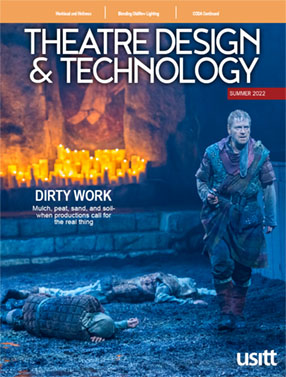Just before the start of the pandemic, my graduate student was designing production that involved filling the stage with dirt. One thing we quickly realized is that, despite anecdotal information from folks who have tried it in the past, no detailed guidance exists in our industry for selecting a natural material to evoke soil on stage. This research gap was matched with a clear need for information as recreating dirt in theatre is a common challenge.
My research questions were: How does a theatre maker choose among common natural materials to select the best product to evoke dirt on stage? And how do these options compare with non-natural options like paint and other theatrical materials? The variables I considered were:
- Cost
- Weight
- Effect on construction/management
- Effect on design/look
- Effect on use/performance
- Effect on air quality
- Effect on costumes
In addition to providing detailed analysis of air particulates, fabric staining characteristics, weight and cost, I also provided seamless, high-resolution images for designers to download and use in their digital designs and modeling. (download available here)
The details of the project are in the article, available as a PDF on the right. Although I was awarded a $1,000 subvention grant from Ohio State to cover rights for the cover photo, I conducted the entire study with no budget, taking advantage of stock from our scenic studio, donated test materials from local businesses, and loaned scientific equipment from colleagues around Ohio State. This highlights the deep transdisciplinarity of this project. In the course of the research, I connected directly with a broad range of scientists, engineers, physicians and theatre makers, including the following:
At Ohio State:
- Dr. Olorunfemi Adetona, Environmental Health Sciences
- Dr. Casey Curtis, Allergy/Immunology Fellow at the Wexner Medical Center
- David Glowacki, USITT Safety & Health Commission
- Dr. Andy May, Civil and Geodetic Engineering
- Jeremy McKinney, College of Arts and Sciences Department of Microbiology
- Mark Reiner, VP Oakland Nursery
- Bill Reynolds, USITT Safety & Health Commission
- Dr. Brian Slater, the Director of Ohio State’s Soil Environment Technology Learning Lab
- Kyle Winkler, Industrial Hygienist, FOD Environmental Health and Safety
- Dr. Lingyin Zhao, specialist in Agricultural Air Quality
Beyond Ohio State:
- Richard Arnold Jr., Assistant Professor and Technical Director, Elmhurst University;
- Robert Bowen, Professor, University of North Carolina Asheville;
- Erin Finnegan, Assistant Properties Director, PCPA
- Dave Glowacki, Director, Robert Goldstine Performing Arts Center
- Roger Hanna, Associate Professor of Set Design, Colorado State University
- Tim Hogan, Properties Director, PCPA
- Eleni Papaleonardos, Artistic Director, Available Light Theatre
- Jörg Ramershoven, Technical Director, Tanztheater Wuppertal Pina Bausch
- William Reynolds, former Director of Theater Safety and Occupational Health at the Yale School of Drama
- Alfred Sheffield, Associate Professor, Grand Valley State University
- Rebecca Turk, Visiting Assistant Professor of Costume Design, Denison University.
